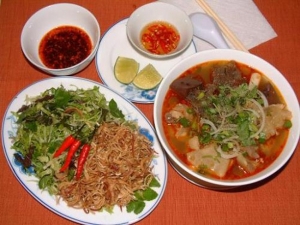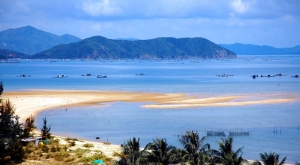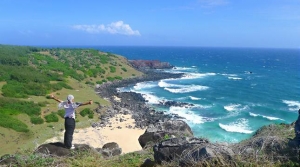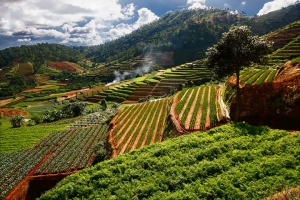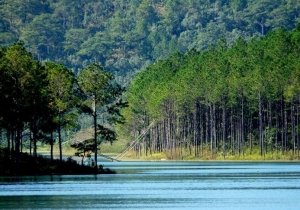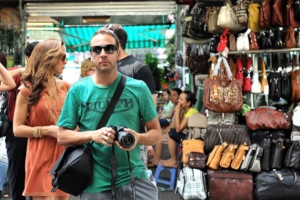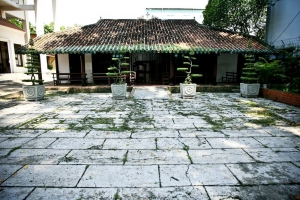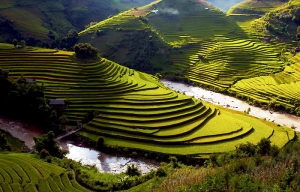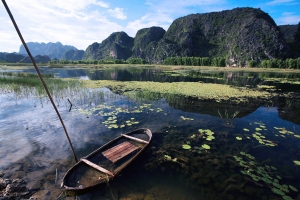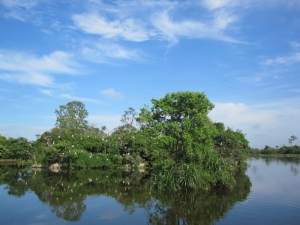
Asia Pacific Travel Team
"Pho" and "Bun bo Hue" - The taste of home in Paris
In Ha Noi, I don't limit myself to eating pho and rice. But after navigating through France's notorious railway strikes for days, exhausted from walking, all I wanted was a hot bowl of noodle soup.
We began our European travels with sandwiches, churros and paella, followed by quiche and salad, crepes and galletes. When we got to Paris, however, we started to crave Vietnamese food.
At the Opera Metro station in the heart of Paris, we spotted a white chalkboard advertising a Vietnamese restaurant. It was a strange location, as most Vietnamese dining places are located in the 13th arrondisement.

Pho (Bowl of noodle soup)
Inside, the dimly lit eatery was unremarkable. There was a small altar and signs in Chinese characters. As in Viet Nam, where green plastic pine leaf decorations and ABBA's "Happy New Year" song pop up all year round, Christmas decorations adorned the ceiling. The server spoke only French and English but managed to pronounce the dishes correctly in Vietnamese.
We ordered one bowl of pho and another of bun bo Hue, which is made with rice vermicelli rather than pho noodles, although the difference between these soups is far more nuanced. While pho is subtly flavoured, bun bo Hue has the strong flavour of shrimp paste and lemongrass due to its origins in the former royal capital city of Hue. In Viet Nam, these two dishes are never served in the same eatery, because the stocks used to make them are so different. But in Paris, I was sure that the stock for these two distinctive dishes came from a single pot!

Bun bo Hue
A Vietnamese friend who lived in Berlin for more than 20 years once took me around the Dong Xuan market there, trying to make the case that the pho soup's quality was far superior to the Vietnamese version. "Look at the bones! The beef bones here are very clean and when people make the stock for pho, they use lots of good bones with marrow, so the stock tastes very good, even better than the stock you have in Viet Nam."
Similarly, when my Vietnamese friends living abroad come home to Ha Noi, I take them out to have pho or bun thang, a Ha Noi-style rice vermicelli soup with shredded chicken and pork sausage. But sometimes they tell me that the pho here does not taste as good as the soup they ate abroad.
Sure, the bones may be cleaner and better overseas, but the stock must also be made with authentic ingredients. Pungent shrimp paste baked in a banana leaf over charcoal fire may not sound very appetising to some western readers, but it's an integral ingredient for bun bo Hue. Pho gia truyen, which translates to "traditional family pho," comes from Nam Dinh province in the north, where families have their own secret recipes that are passed down by mothers to daughters-in-law.
However, maybe I was being too picky. In Paris, could I really expect authentic flavour like the soup in Ha Noi's Old Quarter?
A Vietnamese saying goes, "One bite when one's hungry equals a package when one's full." The meal by the Paris Opera might not have been the most delicious, but it was at least a satisfying taste of home.
Thien Cam beach - The symphony of waves and wind
A primary school student in Ha Noi looked suntanned after a holiday with his family in Thien Cam sea area in the central province of Ha Tinh, but his eyes radiated happiness.
"The sea was so clean and calm, and we could walk hundreds of metres far from the shore. It was easy for children to swim and I had a really great time," Hoang Gia Bao said with a big smile.
Thien Cam, 20 kilometres south of Ha Tinh City, is considered one of most beautiful beaches in northern Central Viet Nam. Located in Cam Xuyen District, it has a beautiful landscape with mountains running along the sea, and it attracts visitors for its wild and natural beauty.
The Thien Cam Mountain, 108 metres above sea level, locally known as Ru Cum, has wide and deep caves.
According to legend, when the 13th King Hung travelled to the south, he stopped by the mountain for a rest. That night, the King heard the sounds of the sea mixed with rustling noises from the pine trees, and imagined the sound of musical instruments in the wind.
The next morning, the King and his entourage climbed up the mountain and thought the terrain looked like a four-chord lute. He decided, then and there, to name the mountain "Thien Cam", literally meaning "The heaven's musical instrument".
In 1407, when Chinese Ming troops invaded Viet Nam, Vietnamese King Ho Quy Ly had to escape to the South, but he was arrested by Ming troops at a cave in Thien Cam. Since then, the cave was named Ho Quy Ly Cave. His son Ho Han Thuong was also arrested on a local beach there.
That's why Thien Cam also means "The heaven's seizing".

A quite beach
"Cam has two meanings, one is 'musical instrument' and the other is 'seizing' and it was not just King Ho Quy Ly who was 'seized' here. During the war with the French, many French soldiers were arrested after a bloody battle on September 4, 1953, in our district," said Dang The Tuan, a local restaurant owner.
I have been to so many beaches throughout the country including Do Son, Cat Ba, Sam Son, Cua Lo, Da Nang, Mui Ne and Phu Quoc, but Thien Cam is perhaps among the few beaches that have very pure water, whose waves are calm, and swimming here is a wonderful experience.
According to locals, from April to September, visitors can swim from 5am to 9pm comfortably and safely.
The beach is about 3km between Thien Cam Mountain and Dau Voi (Elephant Head) Mountain.
The mountains and the small En island, far from the shore, ensure that visitors do not feel overwhelmed by the vastness of the sea that often causes humans to feel alone and insecure.
"Visiting Thien Cam during summer, immersed in the blue waters, watching the red and yellow sky in the sunset, walking on white sand beach while the cool breeze blows over our faces, we recognise the tremendous gifts that Nature has given us," said Quynh Huong, a visitor from Ha Noi.
After a dip in the sea, visitors lie on the plain rocks that look like giant beds beside the beach to watch the clouds drifting past.

Dawn in Thien Cam
Getting a taste of cuttlefish, shrimp, crabs and fish served with local fish sauce give visitors the real feeling of Viet Nam's rich seafood resources.
Before dawn, fishing boats come back after a working night and transport fish and other seafood to the nearby village. The baskets of fresh fish are taken by the women to the local morning markets and sent out to other regions in the province. Cuttlefish still wriggle and the shrimp still flip around. There are pots of fish cooked even on the boats by the fishermen.

Local morning market
"The delicious taste of the fish brings back memories of the Ha Tinh people, so each time they return home they eagerly set foot on the beach with the white sand and blue ocean where they enjoy the grilled fish," said Tuan.
Cam Son is a small, old pagoda high on the mountain. It was built during the Ly dynasty time (1009-1225). Surrounded by blue seas and trees, the air here seems more solemn, quiet and pure.
In the 12th century, the pagoda was destroyed by Champa troops, and its precious items including a big bell, which was brought to the South. The bell is said to be in Cu Lao Cham Island in the southern-central province of Quang Nam.
Cam Xuyen District authorities have recently helped the monks restore and expand the pagoda to meet the aspirations of Buddhist followers and visitors.
Situated along the mountain, the deep, long Ho Quy Ly Cave also became a shelter for Vietnamese forces and their arsenal during the anti-French and anti-American wars.
In the 19th century, the French colonialists built a resort in Thien Cam, but during the wars, these were destroyed. Today, the wild sea is being promoted as a tourism area, with a resort and many hotels dotting the beach.
With the white sand, the mountains, the Ho Quy Ly Cave and a large rock with "footprint of a giant", the locals have made Thien Cam a charming place to visit.
We left Thien Cam when night fell, and looking back we saw the lights from the hotels along the beach and from the floating fishing boats like stars in the sea.
Sounds of waves and winds still followed me all the way to Ha Noi, even entering my dreams. The feelings that Thien Cam aroused in me can never fade.
A trip to unspoiled Island - Phu Quy (Binh Thuan province)
In Phu Quy, a group of ten small islands, only the biggest island, known as Hon Lon (Big Isle) has residents. Hon Trung (Egg Isle) is "the capital" of the sea birds while Hon Tro (Ash Isle) is a new volcanic island formed in 1923.
Every day there is a transport ship leaving the port of Phu Quy in Phan Thiet City to bring locals and visitors from the mainland to visit Phu Quy Islands.
The fares are between VND150,000 and 200,000 either way.
There is also a speed boat that can take you to Phu Quy that takes only two hours instead of the usual five to six, and costs around VND330,000 (US$15). Therefore, Phu Quy island district has now become closer to the mainland.
The landscape of Phu Quy is really beautiful and has some sumptuous cuisine. Despite the long voyage to get there, the tour to Phu Quy still attracts many visitors. As a Vietnamese saying goes, "Yeu nhau may nui cung leo" or "High mountains can't hinder lovers".
The island has an unspoiled charm that woos visitors.
Phu Quy has an abundant source of seafood, contributing towards making Binh Thuan the second largest fishing area in Viet Nam after Kien Giang. The island district has a total area of 32sq.km with a population of 27,000 who live in spacious houses.
Phu Quy is like a generous host who will try to compensate the visitors after a long hard journey. The food is fresh, tasty, cheap and different. It includes "Moon crab" that has red spots on the back that look very strange, and should, perhaps, be called "Sun crab".

Moon crab
Another type of "King crab" is of better quality than those in other areas. Both moon crabs and king crabs have fragrant, sweet meat. Lobsters can be steamed or grilled and make your tongue really "numb". There is buffet of snails which are soft, sweet, delicious and fat.
Fish buffet is another feast that people can't forget that easily, with enough and more of boiled, grilled, fried, steamed fish, cooked porridge, fish soup, and fish rolls, which are always extremely tasty.
Visitors will be surprised by the wealth of Phu Quy. The roads are wide and covered by asphalt. Basaltic soil has made the fruit trees grow luxuriously. These trees include the famous Hoa Loc mango and guava that have a sweet taste, thanks to the climate and soil characteristics.
"Anything in Phu Quy is fresh and surprisingly cheap, from seafood to fruits and meals," said Nguyen Phuc, a visitor from HCM City.
When visiting Phu Quy, happiness meant renting a motorcycle to tour the island, he said.
"We should also get up early to catch the sunrise and wait for the fishing boats to come back. You may pass out in contentment after eating all the different varieties of seafood," Phuc said.
A local fisherman, Nguyen Vu, told guests how to identify different fish, and how to recognise fresh fish by checking the eye of the fish instead of its gills.
Some visitors have fun travelling to the boat houses to learn how to feed the fish and crabs, and have lunch on the sea.

Linh Quang ancient pagoda
Another destination here is Linh Quang ancient pagoda, built in 1747 with the sacred ancient Buddhist statues. Van An Thanh Temple was built in 1781 to worship the Nam Hai (East Sea) Spirit and exhibits a 20m long skeleton of a whale.
The Cao Cat Mountain, which is nearly 100m high, with the Linh Son Pagoda on top and the giant boulder cliffs, is an ideal spot to contemplate the panorama of Phu Quy.
The Nho (Small) and Trieu Duong beaches are very beautiful and clean as they are away from the residential areas.

Trieu Duong beach
There is no big hotel here, but there are decent rest houses, and local people are friendly, Phuc remarked.
Tran Ngoc Can, an official from the island district authorities, said Phu Quy is wild and attractive, but local tourism was still not developed because of poor traffic conditions.
"According to our tourism development plan from now to 2015, with a vision to 2020, Phu Quy District will promote tourism as a key economy sector, improve roads, build more transport ships, and attract investors to build infrastructures on the islands," he said.
But for many visitors, exploring the wild is the ultimate happiness.
"We visit Phu Quy to wash our lungs, eyes and stomach and get rid of all the troubles which we find in town," he said.
When to go ?
The ideal season to visit the Phu Quy islands is from the 3rd to the 6th month of the lunar calendar. All you need is four days to have a wonderful trip. After the 8th month of the lunar calendar, it will be difficult to visit Phu Quy because one can encounter rough seas.
A day as a gardener at Trai Mat (Lam Dong province)
From the city downtown, people can follow Tran Hung Dao and Hung Vuong streets to get to the site after a 20-minute drive on motorbike. Tourists can also take a bus or train to get there.
Along the way, people can admire beautiful pine trees and French-style villas looming under the shades or they can see local farmers planting vegetables on the hills or students with rosy cheeks wearing woolen coats walking on the street.
After strolling on a small path leading to Linh Phuoc Pagoda, tourists will arrive in a valley where they are lost in a vast area of vegetables like carrot, cabbage, strawberry, onion and amaranth.
They can wander along the farm and talk with local people or pick ripped strawberries and carrot by themselves.
People can buy strawberry as present for family and friends at the price from VND150,000 per kilo at the garden.
Then, tourists are advised to visit a nearby market and Linh Phuoc Pagoda, a seven-level tower which was built from glass pieces and a giant Buddha of Mercy statue made from aster flowers.
A farmer showers his garden in Trai Mat

Tourists can pick strawberries at the garden at the price of VND150,000 per kilo

After visiting Trai Mat, tourists are advised to pass by Linh Phuoc Pagoda, one of the popular sightseeing spots in the locality
Tranquility in Tuyen Lam lake (Lam Dong province)
Truc Lam Zen Monastery is also a must-visit destination of the tourist site, where tourists can admire tranquility and peace in mind.
Source: SGT
One day shopping in Saigon
Shopping markets

Ben Thanh market
Ben Thanh market, built by the French in 1870, located in District 1 is a must see destination for most all tourists. Trade is always brisk in the morning as vendors and market goers haggle over everything from clothes, footwear, arts and handicrafts, brocade, jewellery to specialty foods.
As an age-old commercial centre, it draws multitudes of foreigners speaking a multiplicity of languages.
Binh Tay Market (informally referred to as Cho Lon Market) with its elegant Chinese facade topped with distinctive reddish-brown roof tiles, and a yellowy coloured central clock have made it the most attractive and photogenic market in Saigon.

Binh Tay market
Much of the trade that goes on at Binh Tay Market is wholesale. Many Vietnamese who own stalls at other markets purchase wares in bulk at Binh Tay Market for resale at their own market.
The market is heavily stocked with body care products like shampoos, body lotions and creams. It is also especially good for household items and a galore of electronic devises.
If you’re looking for the trendiest most fashionable and multi-stylistic watch, you will most assuredly find it in Binh Tay market, just be prepared to bargain to get it at a good price.
Shopping on demand
On Le Lai street in District 1, just 20 metres far from Ben Thanh market, tourists can choose from a legion of unique and beautiful suitcases or handbags.
Clothes
If you are a fashionista or a tourist with the ability to look beyond the trends set by others and create your own artistic style then you won’t want to miss Saigon Square. The shopping centre gathers both clothes and handbags from common to the sophisticated. Prices are rarely listed, but don’t hesitate to bargain.
Nguyen Trai street at night is also a most fascinating place for purchasing clothes.
Drawings for interior decoration are found on Tran Phu street in District 5. There are generally fewer customers here, tourists can relax and spend more time contemplating the drawings.
HCM City seems to have a specific street for everything, and shoes are no exception. For tourists who like stylist footwear with good quality, they should come to Ly Chinh Thang street in District 3, where the latest and favourite fashions can be found.

Another address is Luu Van Lang street in District 1, to the left of Ben Thanh market. There are sandals for foreigners. A part of this shopping centre is set aside exclusively for children.
Vietnam is often touted as the custom tailoring capital of the world. Tourists searching for a nice cloth for a gift or Ao Dai (traditional long dress), should visit Soai Kinh Lam cloth market.
This is a wholesale market so the prices are cheaper and the choices are more abundant. Cloths are diversified in colour, size and origin.
Antiques street (otherwise known as Le Cong Kieu street) is located just outside Ben Thanh Market. The stores are riddled by imitations but tourists may find a diamond in the rough! Items include copper items (incense burner and altar), wood items (statues of Buddha), porcelain items (plates, bowls) and paper items (stamps and old money).
Be careful when buying “antiques” in Vietnam however as it is illegal to export real antiques out of the country.
Visit Tan Xa, the oldest house in Sai Gon
The chapel (now called Tan Xa) locating at 180 Nguyen Dinh Chieu Street, in the campus of the bishop’s palace in District is considered as the oldest house in HCM City today. In 1790, Nguyen Anh, (Gia Long King) built a bamboo house covering-thatched roof on the right bank of Thi Nghe Canal. It was here that the Bishop tutored one of Nguyen Anh’s sons, the Prince Canh, who lived on-site.
In 1799, after losing Pigneau Pierre, a French bishop and others have to replace in the house, but between 1811 and 1864, the Hue court banned a Catholic, the house was closed. The story of how the French came to be presented with the house is well known. It was given in gratitude for their role in the suppression of the Tay Son rebellion, which resulted in the consolidation of the power of the Nguyen Dynasty in the recently settled lands of the south.

The beleaguered King Nguyen Anh had taken refuge in Thailand, where he had gained the support of the Thais. When the Thai army that entered Vietnam was routed by the Tay Son troops in just two days, there was no alternative now but to accept the French offer of their military intervention in order to save the day.
During the reign of Tu Duc, Mr. King has signed a peace treaty with France to expand the Zoological and Botanical gardens in Thi Nghe parish, the house was transferred to a spot near what is now the Reunification Palace. It was only in 1911 that it was relocated once again to to current location Time it is used as a chapel.

The chapel is built in the traditional architectural style, with three compartments and two lean-tos. Systems and roof tiles ruong short yang has formed an architecture with traditional wood Vietnam walls are thin slats of wood are arranged perpendicular. The wooden walls are not only a role for home protection but also a great ventilation system.

Later in 1945, the wall termite eaten wood has been replaced by brick. During remodeling in 1980, workers replaced the interior of the wooden termite feeding by pouring concrete into. Part exterior wood columns remain; they still seem to look ancient. The workers also had to raise the base column 30 cm. Until now, the Archbishop's Palace is 103 years old while the chapel is 215 years old.
Much is to be learnt from viewing this well restored house, because its original condition has remained unchanged. Coming Ho Chi Minh City, travelers still not forget to visit and contemplate the beauty of the chapel.
Immense terraced rice fields in Mu Cang Chai
Tourists from HCMC can fly to Ha Noi and then rent a car or take a bus to get to Mu Cang Chai, about 280km from downtown Ha Noi. Some local youth opt for conquering Mu Cang Chai by motorbike with the starting point in Ha Noi.
The best time to visit Mu Cang Chai is from mid-September to late October when weather is the best of year and when the immense terrace rice fields there all turn yellow, creating the best image of year.
One month prior to the Mu Cang Chai trip, travelers should make hotel room bookings as thousands of people often rush to the area to view the terrace rice fields in full bloom.
There are some hotels and hostels near Mu Cang Chai area, including Tu Le Commune, Khau Pha Pass and Nghia Lo Town in Yen Bai Province. The three-star Suoi Mo Hotel on Dien Bien Street is highly recommended as this is a convenient hotel in Yen Bai.

Khau Pha pass
It normally takes about three days and two nights to visit all the best terrace rice fields in Tu Le valley, Khau Pha Pass, La Pan Tan, Cau Ba Nha and Che Cu Nha communes. The best time to photograph the terrace rice fields is from 7 a.m. to 9 a.m. when the landscape looks gorgeous in mist and sunlight beams. Rising smoke from the kitchen of a house on stilts may make the scene more beautiful and romantic.
Khau Pha, one of the most magnificent passes of Viet Nam, provides a real breathtaking view. From there travelers can almost touch the clouds hanging over the terrace rice fields in the valleys of H’mong and Thai ethnic minority groups.
Those wishing to explore daily activities of H’mong people should head for La Pan Tan that was recognized as a national tourist attraction in 2007. Some roads in La Pan Tan are under construction so tourists have to walk about 20 minutes. Along the way, tourists can pass by a local resident’s house to see how they live. A typical home in La Pan Tan is covered with ripen corns on the terrace and surrounded by wooden cages for pigs and cows. Women take care of their children or come to the fields with their husbands. During an afternoon break they gather at a small burning stove inside the house to cook and eat. Tourists can also ask locals to perform khen, a traditional pan-pipe played by men in the northern upland to attract women.
A must-see destination is Cau Ba Nha, about 10km from Mu Cang Chai’s center, as it has mam xoi, a giant round shape terrace rice field on the top of a mountain. It is difficult for tourists to get to mam xoi due to a muddy and rough road. They can take a xe om (motorbike taxi) or walk about 30 minutes to reach the top.
Some popular specialties of Yen Bai that tourists should taste and buy for souvenirs are Tu Le sticky rice from Muong Lo field in Yen Bai and green rice flakes originated from Tu Le Commune in Van Chan District. These two products have light sweet and sticky tastes with special aromas. Yen Bai is also known for some dishes such as salmon and sturgeon hotpots, fried bumble bees and steamed chicken, among others.

"Tao meo" in Tu Le valley
Tao meo, a species of small apple in mountainous regions, is a special fruit of Yen Bai as it is good for those having stomach and heart-related diseases and high-blood pressure, and going on a diet. The best tao meo can only be found from September to October.
Discover Trang An Landscape Complex
Trang An Landscape Complex covers an area of 6,172ha in districts of Hoa Lu, Gia Vien, Nho Quan, Tam Diep Town and Ninh Binh City, about 90km to the southeast of Ha Noi.
The complex is surrounded by a buffer zone of 6,268ha, mostly comprising paddy rice fields and villages. As a mixed cultural and natural property, Trang An Landscape Complex contains three protected areas, including Hoa Lu Ancient Citadel Cultural – Historical Area; Trang An – Tam Coc – Bich Dong Scenic Area and Hoa Lu Special-Use Primary Forest.

Located in the humid tropical region, Trang An Landscape Complex is a mountainous area that extends in a northwest-southeast direction. To the north and northwest of Trang An lie Bai Dinh karst hills; to the southwest and the south are Dong Tam – Son Ha and Tam Coc – Bich Dong karst ranges; to the southeast and northeast is Truong Yen karst range; to the northeast and the north is Trang An karst range. River network in Trang An is well developed with Hoang Long River to the north, Chanh River to the east, He River to the south, Ben Dang River to the west and river systems of Sao Khe, Ngo Dong and Den Voi in the heart of the heritage. Trang An Area was invaded and reworked by the sea many times in the recent geological past but is now emergent on land. Landform development over a period of more than five million years produced scenic landscape of extraordinary beauty – a blend of towering cliff-bounded mountains draped in natural rain forest, surrounded by huge and deeply developed internal basins whose clear and quietly flowing waters are connected through a myriad of underground streams and caverns, many of which are navigable by small sampans carrying tourists.
* Outstanding values
Cultural value

Trang An is a prominent place in Southeast Asia and the world which contains abundant archaeological evidences preserved almost intactly, mostly shells, animal bones, pottery, stone tools, kitchen floor and human remains. This is an extremely valuable documentary treasure demonstrating the way that prehistoric human interacted with natural landscape and adapted to major changes of environment over more than 30,000 years, at least since the late Ice Age. During this time, they endured some of the most turbulent climatic and geographical changes in the Earth's history. Besides, cultural and historical relics such as pagodas, temples, palaces in Trang An also contribute to consolidating many archaeological documents.
Aesthetic value

The karst tower landscape of Trang An is among the most beautiful and awe-inspiring places of its kind anywhere in the world. Dominating the landscape is a spectacular array of cone-shaped rock towers whose sheer vertical walls rise abruptly 200m above the surrounding land and water. Narrow interconnecting ridges, which have been likened to mythical giant swords, enclose circular and linear depressions whose expansive waterways are linked by gently flowing streams winding through subterranean caverns up to one kilometer in length. Visitors, carried through these passages in small traditional sampans, can enjoy the multitude of fascinating carbonate stalactites, curtains and other decorations that adorn the ceilings. Dense rain forest covers the landscape, even clinging to the cliffs and peaks. Blending naturally and beautifully with the forests are the extensive rice paddy fields bordering the rivers, creating a picturesque patchwork of color, enlivened by the presence of local farmers and fisher folk engaged in their traditional way of life. Several historic temples and pagodas, some perched high on the valley walls and peaks, signify the important spiritual and religious associations with the landscape. The countryside of the surrounding buffer zone presents a picture of traditional rural life with gardens and fields among small villages linked by simple tracks, narrow roads and a network of streams and canals.
Geological and geomorphological value

Trang An displays the end stages of karst tower landscape evolution in a humid tropical environment. The product of deep dissection of an uplifted limestone massif over a period of millions years is a remarkable array of classical karst landforms, including cones and towers, depressions (cockpits), valleys (poljes), rockfall collapse structures and deposits, subterranean caverns and rivers, caves and speleothems. A network of cross-cutting parallel faults divides the area into cells and promotes the development of enclosed depressions. An altitudinal series of erosional notches in rock walls with associated caves, wave-cut platforms, beach deposits and marine shells is evidence of former stands of sea level.
On 23 June 2014, in Doha (Qatar), World Heritage Committee of United Nations Educational, Scientific and Cultural Organization (UNESCO) recognized officially Trang An Landscape Complex as World Cultural and Natural Heritage Site based on three criteria: culture, aestheticism and geology – geomorphology.
Main tourist sites
Hoa Lu Ancient Citadel Cultural – Historical Area: King Dinh Temple, King Le Temple, Co Am Pagoda, Kim Ngan Pagoda, Duyen Ninh Pagoda, Nhat Tru Pagoda, Thien Ton Grotto…
Trang An Scenic Area: Trinh Temple, Tran Temple, Tu Tru Temple, Dia Linh Cave, Sinh Duoc Cave, May Cave, Nau Ruou Cave, Bai Dinh Pagoda Complex…
Tam Coc – Bich Dong Scenic Area: Bich Dong Pagoda, Linh Coc Pagoda, Thai Vi Temple, Thien Huong Grotto, Tien Grotto, Thien Ha Grotto, But Cave, Mua Cave, Ca Cave, Thung Nham, Thung Nang, Co Vien Lau Ancient Village…
Thu Giang
Stork Island ( Dao Co ) in Hai Duong
Making a journey to Co Island, excursionists will be amazed to witness nests of storks hung on branches and baby storks learning to fly on bamboo tops.
Their twitters in harmony with the murmur of leaves and whisper of winds together with the buzz of other insects make a symphony for tourists to relax and leave daily stresses behind.

Moreover, the peaceful and splendid surroundings is another reward for tourists. An Duong Lake in the island is also home to many fish and many aquatic species, many of which are listed in the Red Book of Viet Nam. Locals say that September is the time that thousands of storks and birds come to the island and stay until April of the following year.
Since 1994, local authorities have preserved and developed tourism for the island, attracting about 40,000 tourists every year. They grow more plants and trees to offer more space for birds.
Authorities have also approved a project on developing and preserving the ecological system in Co Island. The project costs VND100 billion and includes three phases which will be completed by 2015, according to Vietnamplus.
If tourists have a chance to visit Hai Duong Province, Co Island is a must-see place that should not be missed.


